Use scroll bar at right to scroll down
page
The History of Fayetteville Senior High School
First, some background about the first public schools:
Early education in Fayetteville and how the grade schools were
established make an interesting story.
A 1754 deed conveyance to Mr. John Newberry indicates the
presence of a schoolhouse on the lower side of Cross Creek
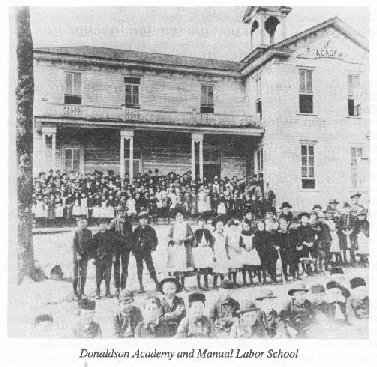 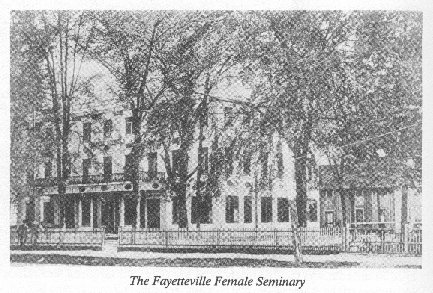 In 1794, the Fayetteville Academy was established with the Rev.
David Kerr principal. It burned in the "great fire" of
1831. The Ravenscroft Academy was established in 1831 by the Methodist,
and in 1832, Donaldson Academy was established. It was located one mile
west of the Market House on a 30 acre site purchased on Hay Mount, a pleasant
hill overlooking the town of Fayetteville. The Female Seminary opened
around 1855. This fine building with large front balcony was located on
the South side of Hay Street in the vicinity of the Miracle and Colony Theaters
of today's period. In 1794, the Fayetteville Academy was established with the Rev.
David Kerr principal. It burned in the "great fire" of
1831. The Ravenscroft Academy was established in 1831 by the Methodist,
and in 1832, Donaldson Academy was established. It was located one mile
west of the Market House on a 30 acre site purchased on Hay Mount, a pleasant
hill overlooking the town of Fayetteville. The Female Seminary opened
around 1855. This fine building with large front balcony was located on
the South side of Hay Street in the vicinity of the Miracle and Colony Theaters
of today's period.
There were many small private schools: a kindergarten by Mrs.
Kate Utley in 1832; Misses Ellison's School; Miss Mabel Bingham's; Misses
Mallett's School; Miss Philadelphia Matthews'; Miss Columbia Mims' School; and
probably others.
In 1867, the black citizens of Fayetteville agreed to establish
a school for the benefit of their children. Gen. O. O. Howard of the
Freedman's Bureau agreed to erect a building. The school became the Howard
School, which was renamed the State Colored Normal School by act of legislature
in 1877.
Around 1875 The Peabody Fund offered One Thousand dollars to
any city or town that would make an average attendance of three hundred
pupils. Greensboro, Morehead City and Fayetteville made an effort and
failed. Raleigh levied a tax of ten cents and enrolled three hundred
seventy five pupils in the Governor's Mansion no higher than six grade.
In 1878, Greensboro had one hundred twenty pupils with four
grades. The Colored School that was established in Fayetteville in 1867
also received from the Peabody Fund.
In 1878 in lower Fayetteville, there was a difficulty between
two white men one Sunday afternoon. They were tried in the Market
House on Monday. Six white boys and six colored boys were witnesses.
At the end of the trial, the six colored boys signed their names but the six
white boys could not write. All Fayetteville was looking on when this
happened. The people were greatly disturbed. They did not blame the
Negroes but they blamed themselves. Not waiting for the Legislature to
meet, everyone subscribed from five cents up to two hundred fifty dollars.
A fund of Thirty five hundred dollars was made and teachers elected. There
were several local people, an officer of the United States Navy and a gentleman
from New England canvassed for Superintendent. They met on Saturday
night and no one up until 12 o'clock received a majority. Alexander
Graham, a local resident, teacher and lawyer had refused to be a candidate and
was out of town. Someone nominated him and after several ballots, he
was elected the first superintendent of Fayetteville Graded Schools.
The school was established in three places; Donaldson Academy
on Haymount, the Fayetteville Female Seminary and in Campbellton, lower
Fayetteville. The school began September 5, 1878 with an enrollment of
five hundred pupils, the largest in the state. The average number of
pupils for the first year was three hundred which gave the school Eight Hundred
dollars from the Peabody Fund. This amount was paid to the
Superintendent. The first high school was established in Fayetteville
teaching Latin, Greek, French and German. By 1881 the school prepared and
sent boys to the university.
In 1882 Superintendent Alexander Graham personally escorted two
young ladies and one young man to the University for enrollment in the Classical
Department. They all passed the examination. After some hesitation
by the Professors, due to the fact that these students had come from graded
schools, they all signed their certificates. The Peabody Fund ceased to
aid the graded schools and devoted their money to the high schools and the
normal schools. Fayetteville received six hundred dollars for her high
school.
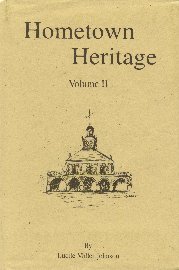 The above information
and pictures is taken from Lucile Miller Johnson's
book, Hometown Heritage, Volume II, published 1992 by Taylor Publishing
Company, Dallas, Texas in cooperation with The Woman's Club of Fayetteville,
Fayetteville Publishing Company and the Florence Rodgers Charitable Trust. The above information
and pictures is taken from Lucile Miller Johnson's
book, Hometown Heritage, Volume II, published 1992 by Taylor Publishing
Company, Dallas, Texas in cooperation with The Woman's Club of Fayetteville,
Fayetteville Publishing Company and the Florence Rodgers Charitable Trust.
Schools We Remember
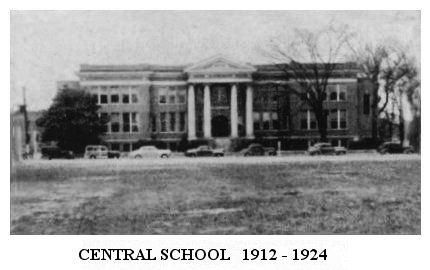 Central School, located at the corner of Burgess Street and
Maiden Lane, was built in 1911 and opened in the middle of the school year of
1912. Was the High School until 1924. It was then converted to a
grade school, 1st
through 6th grades and used until February, 1960. Demolished in October,
1963 is now a parking lot opposite the Cumberland County Public Library. Central School, located at the corner of Burgess Street and
Maiden Lane, was built in 1911 and opened in the middle of the school year of
1912. Was the High School until 1924. It was then converted to a
grade school, 1st
through 6th grades and used until February, 1960. Demolished in October,
1963 is now a parking lot opposite the Cumberland County Public Library.
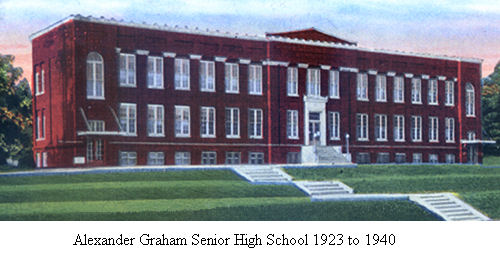
A new high school, named in honor of the distinguished Alexander Graham opened for fall classes on
September 23, 1923. Located on McGilvary Street the grades were limited to eleven.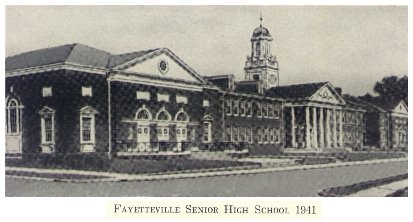
On September 10, 1940, Clyde R. Hoey, then Governor of North Carolina,
dedicated the new Fayetteville Senior High School located a few hundred feet
East of the older building on Robeson
Street. Upon opening of school the 12th grade was inaugurated for the
first time. This building with Greek and Classical Revival architecture
was clearly one of Fayetteville's most beautiful buildings. The Architect
was William Henry Deitrick, designer of the Dorton Arena in Raleigh.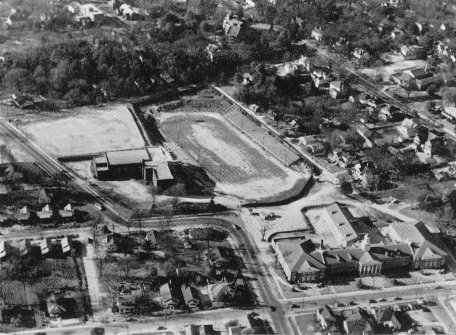
The previous high school was renamed the Alexander Graham Junior High
School. This was the Junior High that our Class of 51 attended. City
Elementary schools from which we came were Haymount, Central and Person
Street. A few of us came from outside our city. We knew them as
"Bragg Brats".
Now Fayetteville Senior High is cherished in our memory. We and the
other graduating classes; the alumnae of those years. We can only remember for the school and its
building no longer exist. The Class of 1954 was the last graduating class
to have used it's halls of learning. Approximately 2,300 students graduated while
it was a high school. In June, 1953 construction was started on a new high
school located on Fort Bragg Road. In October, 1954 the student body moved to
the new
facility. In 1968, that school was renamed Terry
Sanford High School. The name Fayetteville Senior High School, with
classes 1912 to 1967 ceased to exist.
The Robeson Street building, which had opened as a high school in 1940, then
became Alexander Graham Junior High School. After two middle schools were
built the Robeson Street school closed its doors in 1977. Efforts to
utilize the building as a library never materialized and so its fate was
sealed.
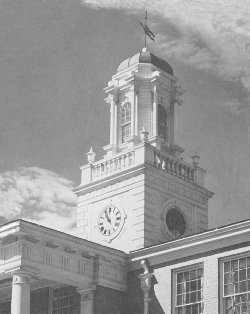 In August 1981 the building was demolished to make way for the new
Highsmith-Rainey Hospital. Most of us thought it sad especially since it
had many years of life remaining. The magnificent white cupola with its
copper roof, railings and clock was saved from destruction by Joe Hollinshed and
Wm. K. Kiley with hopes of preservation. However, after lingering on a
Grove Street city owned lot and exposed to the elements for a number of years,
it was sold. Whereabouts has since been traced to somewhere in South Carolina. In August 1981 the building was demolished to make way for the new
Highsmith-Rainey Hospital. Most of us thought it sad especially since it
had many years of life remaining. The magnificent white cupola with its
copper roof, railings and clock was saved from destruction by Joe Hollinshed and
Wm. K. Kiley with hopes of preservation. However, after lingering on a
Grove Street city owned lot and exposed to the elements for a number of years,
it was sold. Whereabouts has since been traced to somewhere in South Carolina.
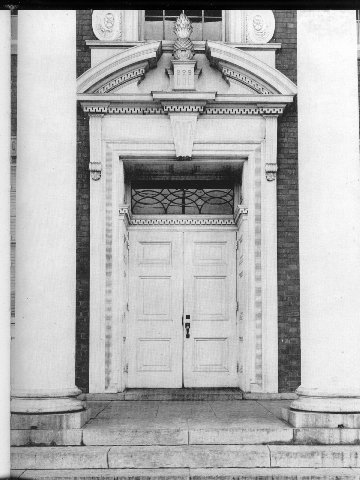

We
have seen irreplaceable treasures
destroyed in the name of progress or necessity. At great loss is the fine
artistic workmanship exampled by the many beautiful Doric columns, entrances, window arches and
decorative gables of our Alma Mater.
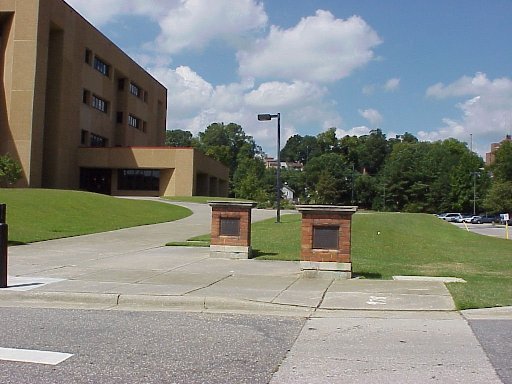
Two
markers have been erected with brick from the original school buildings.
Located on the east side of the New Health Department building and south of the
New Highsmith-Rainey Hospital, the bronze plaques are inscribed:
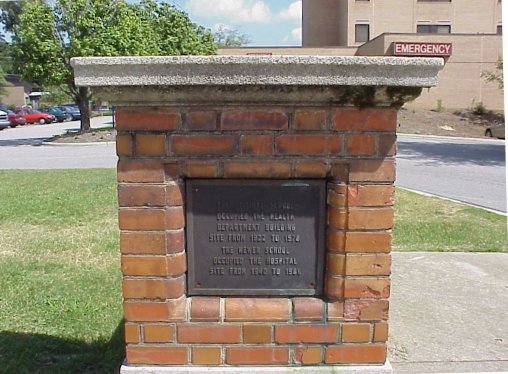
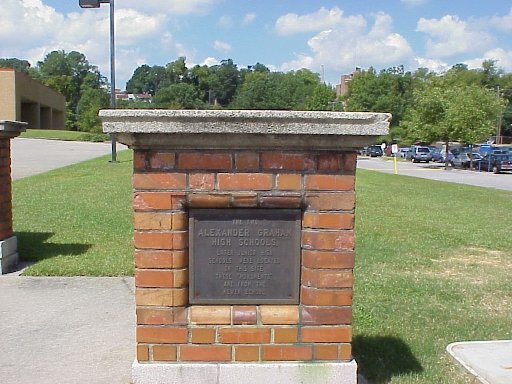
"THE ORIGINAL SCHOOL
"THE TWO
OCCUPIED THE
HEALTH ALEXANDER GRAHAM
DEPARTMENT
BUILDING HIGH SCHOOLS
FROM 1922 TO
1978. LATER JUNIOR HIGH
THE NEWER
SCHOOL SCHOOLS WERE LOCATED
OCCUPIED THE
HOSPITAL
ON THIS SITE.
SITE FROM 1940 TO 1981" THESE MONUMENTS
ARE FROM THE
NEWER SCHOOL"
Acknowledgement is given the Fayetteville Observer,
Library Department, for their kind assistance.

 |